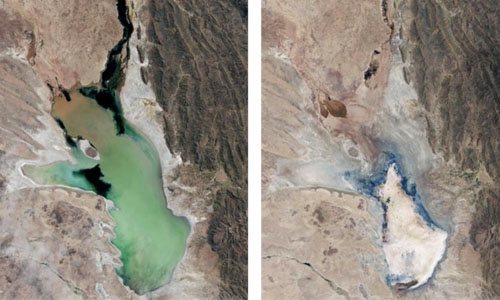
Bolivia’s Second-Largest Lake Dries Up: Is Utah’s Great Salt Lake Next?

The diminishing supply has led water managers to import water from the Colorado River, which is itself at “extreme risk” from overallocation, according to Gary Wockner, executive director of Save The Colorado. And the area’s increased reliance on the Colorado River is still not enough.
“Reduced stream flows have been offset by eight percent with imported water from the Colorado River Basin through the Central Utah Project, as well as return flows from upstream diversions,” the authors noted. “Overall, however, consumptive water use has reduced net river inflow to the lake by 39 percent over the past 150 years.”
“Any future development of water will cause the lake to drop more,” researchers cautioned. “For example, the Utah Division of Water Resources estimates that water consumption associated with the proposed Bear River Development Project would decrease the level of Great Salt Lake approximately 8.5 inches. This would expose about another 30 square miles of lake bed.”
“The logic is straightforward,” the authors added. “If less water is delivered to the lake, the lake level must drop. This is an inevitable consequence of ever increasing water consumption.”
The story of Bolivia’s Lake Poopó should serve as a warning for what can happen when water resources are mismanaged. Poopó historically has been 380 square miles or about twice the size of Los Angeles with a maximum depth of 16 feet.
Another victim of climate change. Lake Poopó, Bolivia’s 2nd largest lake, at 400 sq. miles. https://t.co/BQSt8JpAsk pic.twitter.com/seSdZzZFLf
— Mark Ohe (@mark_ohe) January 28, 2016
Currently though, it’s a mere two percent of its former water level, regional governor Victor Hugo Vasquez told The Guardian. And though lake levels have fluctuated with the weather in the past, scientists worry recovery may no longer be possible.
In December 2015, the lake was “officially declared evaporated,” according to The Guardian, displacing hundreds, if not thousands, of people and sparking an ecological disaster for hundreds of species.
#Photos Of The Day: #Bolivia’s Second-Largest Lake Disappears @MNetNews #climate #LakePoopo https://t.co/4kKciEmR3s pic.twitter.com/dEXCwauIzt
— Katie Gerhards (@KatieGerhards) January 26, 2016
The Bolivian government blames El Niño and climate change for the particularly dry weather, but National Geographic said, “that’s not the whole story.”
“Misuse of the water supply and a failure on the part of the Bolivian government to act on existing management plans are partly responsible for the rapid drying of the lake over the past few years,” Lisa Borre, a senior researcher with the Cary Institute for Ecosystem Studies in New York, explained to National Geographic.
“The lake was very shallow, only a few feet deep, and it is in an arid climate, so its level fluctuates a lot with the weather,” Borre said, noting that Poopó has shrunk significantly a number of times in the past, “but it’s never been this bad.”
National Geographic explained how lake levels dropped so dangerously low:
“Lake Poopó gets most of its water from the Desaguadero River, which flows from Lake Titicaca (Bolivia’s largest lake). According to the published management plan, water managers are supposed to allow flow down the river into Poopó, but they have recently allowed that to slow to a trickle.
Titicaca has plenty of water in it, so that’s not the problem, Borre says. Officials just aren’t opening control gates often enough to send water down the river. Some of the water is being diverted for agriculture and mining. And even when water is available, the river is often clogged with sedimentation, due to the runoff from development and mining in the area.
Poopó is high, at 12,000 feet (3,680 meters), and the area has warmed an estimated one degree Celsius over the past century, leading to an increase in the rate of evaporation from the lake. And the lack of rain over the past year has sped the process even further. But these factors weren’t surprises, Borre says, they were foreseeable changes that scientists anticipated.
What happened to Lake Poopó is not unlike the drying of the vast Aral Sea in Central Asia, says Sandra Postel, director of the Global Water Policy Project and a National Geographic Explorer. In both cases, a closed water system was overdrawn, with more water going out than coming in.
Though researchers disagree over whether the lake will rebound, one thing remains clear. “This is a picture of the future of climate change,” Dirk Hoffman, a German glaciologist, told The Guardian.
YOU MIGHT ALSO LIKE
Drought in Syria Likely the Worst in 900 Years
7 NASA Selfies Show Just How Much Our Climate Is Changing

 233k
233k  41k
41k  Subscribe
Subscribe 